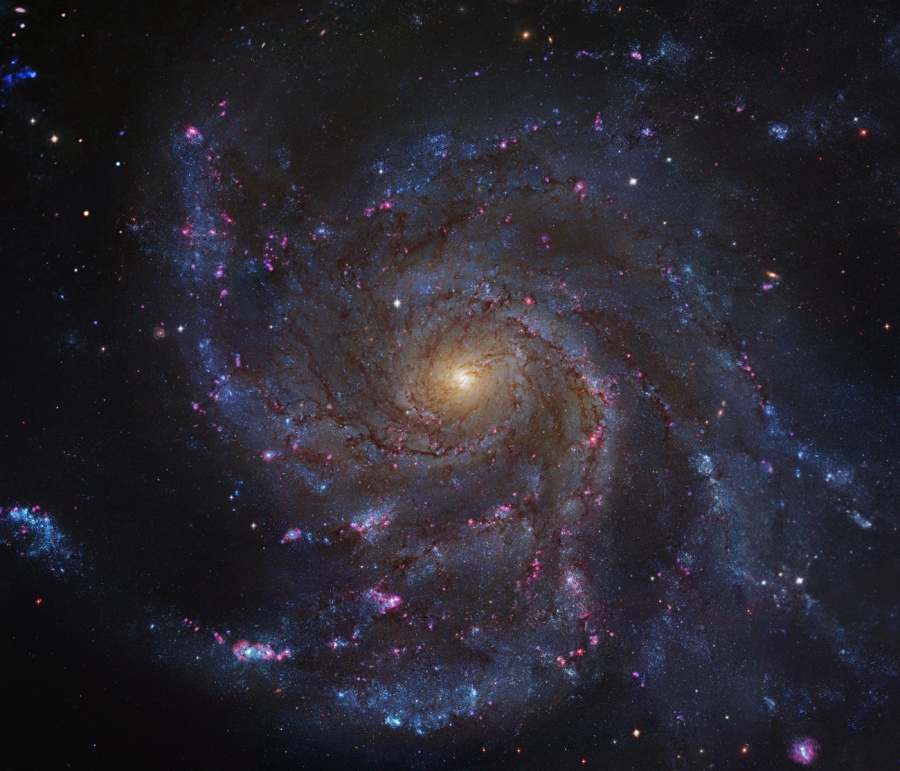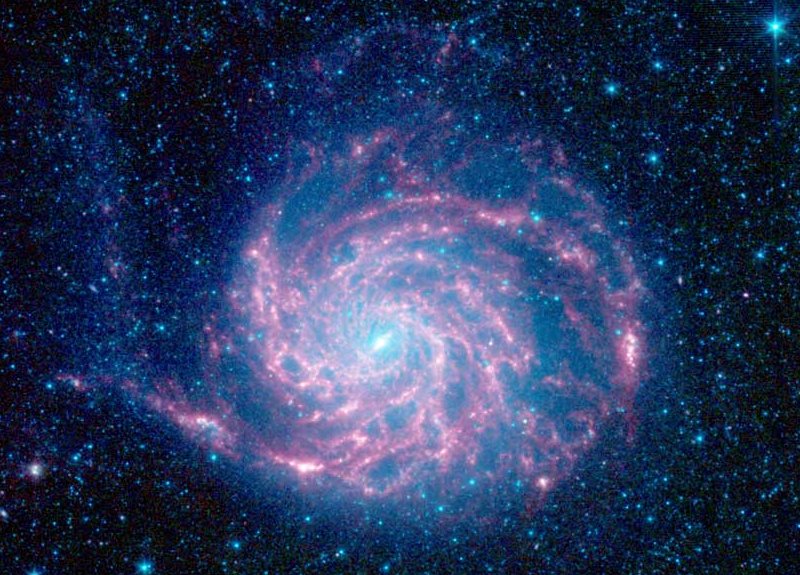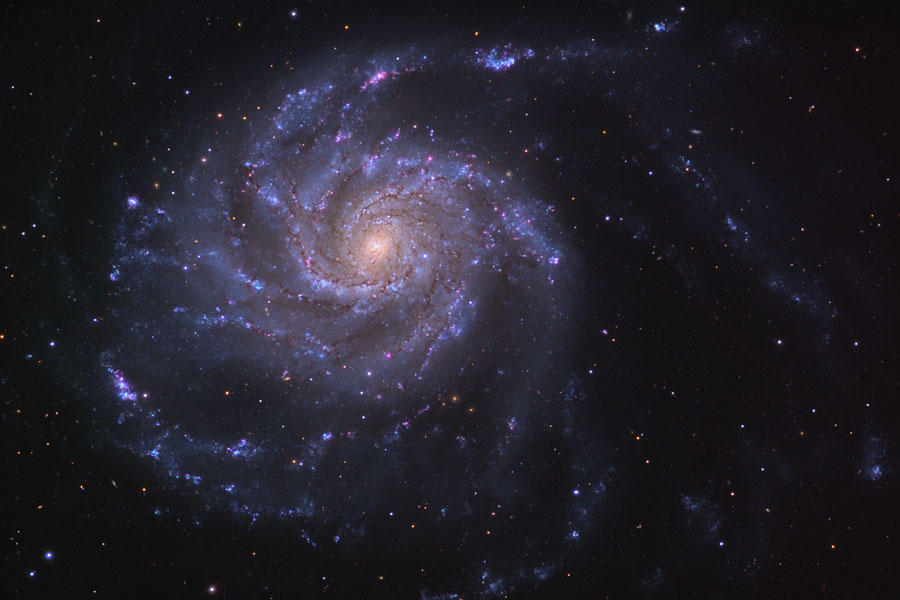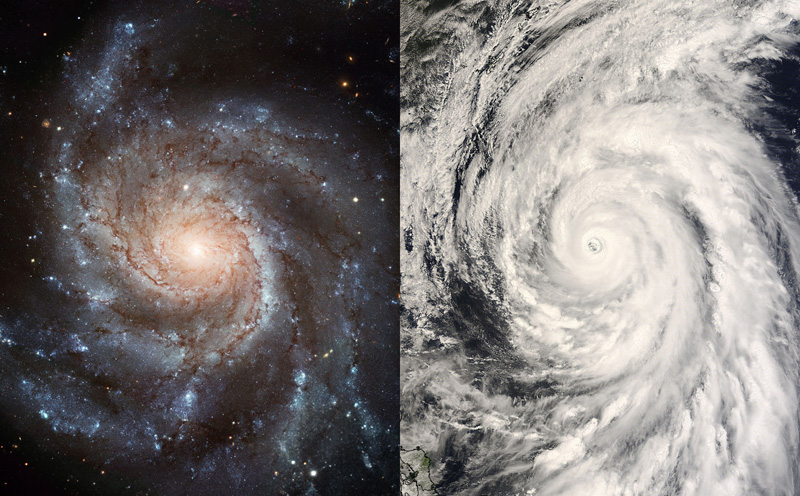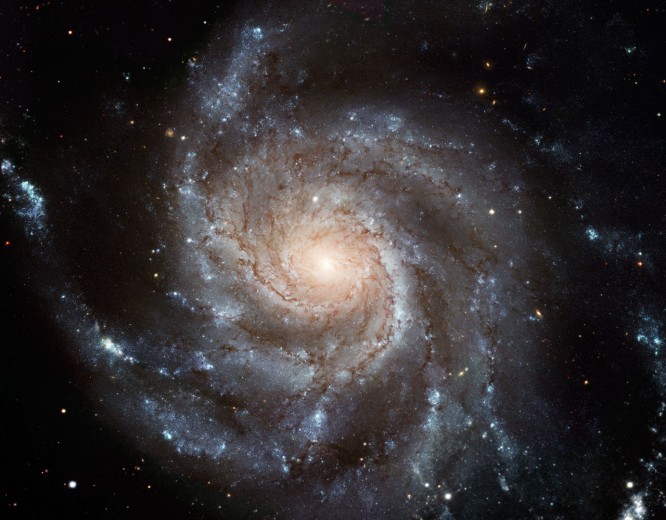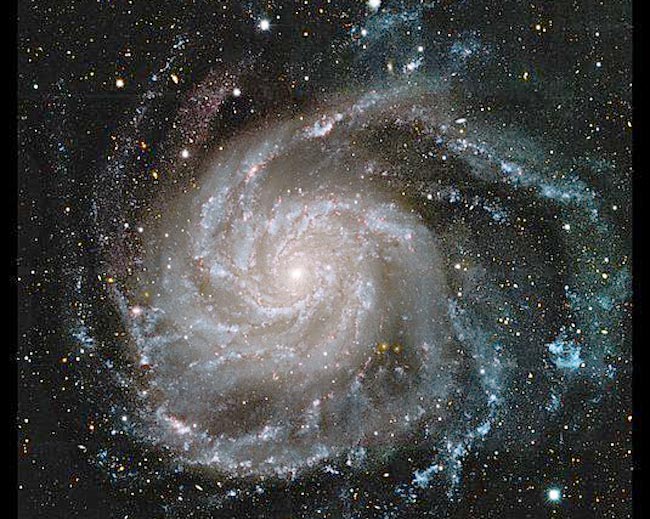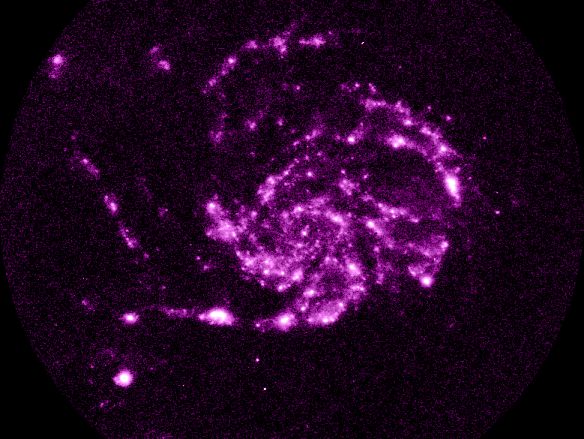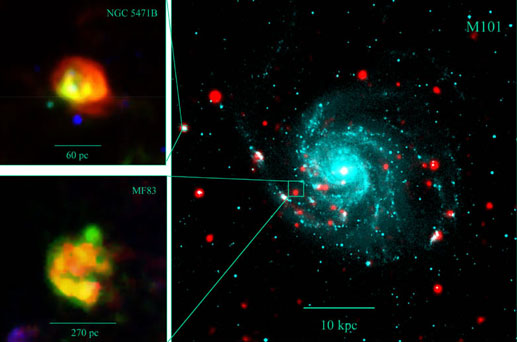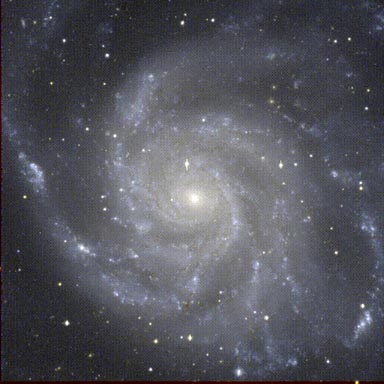Spiral Galaxy M101
All titles are clickable and link to the original APOD page. Click on an image for a larger view of it.
2011 April 15 Big, beautiful spiral galaxy M101 is one of the last entries in Charles Messier's famous catalog, but definitely not one of the least. About 170,000 light-years across, this galaxy is enormous, almost twice the size of our own Milky Way galaxy. M101 was also one of the original spiral nebulae observed by Lord Rosse's large 19th century telescope, the Leviathan of Parsontown. This mosaic of M101 was assembled from Hubble Legacy Archive data. Additional ground-based data was included to further define the telltale reddish emission from atomic hydrogen gas in this gorgeous galaxy's star forming regions. The sharp image shows stunning features in the galaxy's face-on disk of stars and dust along with background galaxies, some visible right through M101 itself. Also known as the Pinwheel Galaxy, M101 lies within the boundaries of the northern constellation Ursa Major, about 25 million light-years away.
2009 December 30 Big, beautiful spiral galaxy M101 is one of the last entries in Charles Messier's famous catalog, but definitely not one of the least. About 170,000 light-years across, this galaxy is enormous, almost twice the size of our own Milky Way Galaxy. M101 was also one of the original spiral nebulae observed by Lord Rosse's large 19th century telescope, the Leviathan of Parsontown. Recorded at infrared wavelengths by the Spitzer Space telescope, this 21st century view shows starlight in blue hues while the galaxy's dust clouds are in red. Examining the dust features in the outer rim of the galaxy, astronomers have found that organic molecules present throughout the rest of M101 are lacking. The organic molecules tracked by Spitzer's instruments are called polycyclic aromatic hydrocarbons (PAHs). Of course, PAHs are common components of dust in the Milky Way and on planet Earth are found in soot. PAHs are likely destroyed near the outer edges of M101 by energetic radiation in intense star forming regions. Also known as the Pinwheel Galaxy, M101 lies within the boundaries of the northern constellation Ursa Major, about 25 million light-years away.
2009 April 14 Why do many galaxies appear as spirals? A striking example is M101, shown above, whose relatively close distance of about 27 million light years allows it to be studied in some detail. Recent evidence indicates that a close gravitational interaction with a neighboring galaxy created waves of high mass and condensed gas which continue to orbit the galaxy center. These waves compress existing gas and cause star formation. One result is that M101, also called the Pinwheel Galaxy, has several extremely bright star-forming regions (called HII regions) spread across its spiral arms. M101 is so large that its immense gravity distorts smaller nearby galaxies.
2008 May 17
Uncomfortably close Typhoon Rammasun (right) and 25 million light-year distant galaxy M101 don't seem to have much in common. For starters, Rammasun was only a thousand kilometers or so across while M101 (aka the Pinwheel Galaxy) spans about 170,000 light-years, making them vastly dissimilar in scale, not to mention the different physical environments that control their formation and development. But they do look amazingly alike: each with arms exhibiting the shape of a simple and beautiful mathematical curve known as a logarithmic spiral, a spiral whose separation grows in a geometric way with increasing distance from the center. Also known as the equiangular spiral, growth spiral, and Bernoulli's spiral or spira mirabilis, this curve's rich properties have fascinated mathematicians since its discovery by 17th century philosopher Descartes. Intriguingly, this abstract shape is much more abundant in nature than suggested by the striking visual comparison above. For example, logarithmic spirals can also describe the tracks of subatomic particles in a bubble chamber, the arrangement of sunflower seeds and, of course, cauliflower.
2006 March 2
Big, beautiful spiral galaxy M101 is one of the last entries in Charles Messier's famous catalog, but definitely not one of the least. About 170,000 light-years across, this galaxy is enormous, almost twice the size of our own Milky Way galaxy. M101 was also one of the original spiral nebulae observed by Lord Rosse's large 19th century telescope, the Leviathan of Parsontown. Assembled from 51 exposures recorded by the Hubble Space Telescope in the 20th and 21st centuries, with additional data from ground based telescopes, this mosaic of M101 is touted as the largest, most detailed spiral galaxy view ever released from Hubble. The sharp image shows stunning features along the galaxy's face-on disk of stars and dust along with background galaxies, some visible right through M101 itself. Also known as the Pinwheel Galaxy, M101 lies within the boundaries of the northern constellation Ursa Major, about 25 million light-years away.
2003 March 10 Why do many galaxies appear as spirals? A striking example is M101, shown above, whose relatively close distance of about 22 million light years allow it to be studied in some detail. Recent evidence indicates that a close gravitational interaction with a neighboring galaxy created waves of high mass and condensed gas which continue to orbit the galaxy center. These waves compress existing gas and cause star formation. One result is that M101, also called the Pinwheel Galaxy, has several extremely bright star-forming regions (called HII regions) spread across its spiral arms. M101 is so large that its immense gravity distorts smaller nearby galaxies.
2000 June 10 This picture of giant spiral galaxy Messier 101 (M101) was taken by the Ultraviolet Imaging Telescope (UIT). UIT flew into orbit as part of the Astro 2 mission on-board the Space Shuttle Endeavour in March 1995. The image has been processed so that the colors (dark purple through white) represent an increasing intensity of ultraviolet light. Pictures of galaxies like this one show mainly clouds of gas containing newly formed stars many times more massive than the sun, which glow strongly in the ultraviolet. In contrast, visible light pictures of galaxies tend to be dominated by the yellow and red light of older stars. Ultraviolet light, invisible to the human eye, is blocked by ozone in the atmosphere so ultraviolet pictures of celestial objects must be taken from space. M101 is a mere 22 million light-years away in the constellation Ursa Major. Its popular moniker is the Pinwheel Galaxy.
April 20, 1999 What created these huge explosion remnants? Speculation has been building recently that outbursts even more powerful than well-known supernovae might occur. Dubbed hypernovae, these explosions might result from high-mass stars and liberate perhaps ten times more energy than conventional supernovae. A hypernova was originally postulated to explain the great amount of energy seemingly liberated in a gamma-ray burst. A search for visible remnants of hypernovae has now yielded the above two candidates. Nearby spiral galaxy M101, shown on the right, has two large expanding shells that might have originated from a hypernova. Remnant NGC 5471B on the upper left and MF83 below were identified by the unusually high amount of X-ray radiation they emit. MF83 is also one of the largest expanding shells ever found. Research continues into the possible nature and visibility of hypernovae and the gas shells they likely leave behind.
August 5, 1997 Why do many galaxies appear as spirals? A striking example is M101, shown above, whose relatively close distance of about 22 million light years allow it to be studied in some detail. Recent evidence indicates that a close gravitational interaction with a neighboring galaxy created waves of high mass and condensed gas which continue to circle the galaxy. These waves compress existing gas and cause star formation. One result is that M101, also called the Pinwheel Galaxy, has several extremely bright star-forming regions (called HII regions) spread across its spiral arms. M101 is so large that its immense gravity distorts smaller nearby galaxies.
June 27, 1995 This giant spiral galaxy, Messier 101 (M101), was photographed by the Ultraviolet Imaging Telescope onboard the Space Shuttle Endeavour during the Astro-2 mission (March 2 - 18, 1995). The image has been computer processed so that the colors represent the intensity of ultraviolet light. Pictures of galaxies like this one show mainly clouds of gas containing newly formed stars many times more massive than the sun, which glow strongly in ultraviolet light. In contrast, visible light pictures of galaxies tend to be dominated by the yellow and red light of older stars. Ultraviolet light, invisible to the human eye, is blocked by ozone in the atmosphere so ultraviolet pictures of celestial objects must be taken from space.
